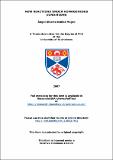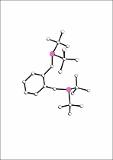Files in this item
New reactions under homogeneous conditions
Item metadata
| dc.contributor.advisor | Cole-Hamilton, D. J. (David John) | |
| dc.contributor.author | Núñez Magro, Ángel Alberto | |
| dc.coverage.spatial | 263 | en |
| dc.date.accessioned | 2008-05-15T09:33:02Z | |
| dc.date.available | 2008-05-15T09:33:02Z | |
| dc.date.issued | 2007 | |
| dc.identifier | uk.bl.ethos.552062 | |
| dc.identifier.uri | https://hdl.handle.net/10023/482 | |
| dc.description.abstract | BDTBPMB has been proven to be an essential ligand in carbonylation chemistry. Its two tert-butyl groups and wide bite angle give it the ideal characteristics for this kind of chemistry, and leads to high activity and selectivity with use of its complexes. During this work the group of reactions where this ligand has been proven to be active has been extended with two new protocols for hydroxycarbonylation and aminocarbonylation. In the hydroxycarbonylation process, a large variety of unsaturated compounds were studied. Dioxane was found to be the ideal solvent, due to its properties in terms of coordinability, and miscibility with water. Using this solvent as the medium, a BDTBPMB complex of palladium was found to be highly active and selective under mild conditions. Initial attempts to address the aminocarbonylation of alkenes catalysed by the Pd/BDTBPMB system did not give high activity. This problem was overcome by the addition of an arylalcohol. Under those conditions, high selectivity and conversion was obtained in a wide variety of amides. However, attempts to address the aminocarbonylation of alkenes with ammonia gas to generate primary amides did not result in any conversion. The generation of these primary amides was obtained with transamidation of N-phenylnonamides which can be prepared by aminocarbonylation. Amides have been successfully hydrogenated to amines catalysed by a Ru/Triphos system. This system has been proven to be highly active in this reaction. High selectivities have been obtained in the generation of secondary amine. However, initial results of the hydrogenation of primary amides resulted in no formation of primary amines. A careful analysis of the mechanism of the formation of various products from the hydrogenation of primary amides allows the selective formation of primary amines by the ruthenium/Triphos system in the presence of ammonia. The possibility of the generation of primary amides in situ from acids under hydrogenation conditions, giving primary amines was explored with high conversion and moderate selectivities.To complete this work, a system based on a palladium complex for the decarboxylation of benzoic acids was developed. Usually, the decarboxylation reactions catalysed by copper require high temperatures. However, palladium complexes of highly electron donating ligands such as BDTBPMB or P(ᵗBu)₃ were found to be highly active under milder conditions. This catalytic system was proven to be active in desulfonation reactions giving high conversion. | en |
| dc.format.extent | 2675 bytes | |
| dc.format.mimetype | application/pdf | |
| dc.language.iso | en | en |
| dc.publisher | University of St Andrews | |
| dc.rights | Creative Commons Attribution-NonCommercial-NoDerivs 3.0 Unported | |
| dc.rights.uri | http://creativecommons.org/licenses/by-nc-nd/3.0/ | |
| dc.subject.lcc | QD505.N8 | |
| dc.subject.lcsh | Catalysis | en |
| dc.subject.lcsh | Carbonyl compounds--Synthesis | en |
| dc.subject.lcsh | Amides | en |
| dc.title | New reactions under homogeneous conditions | en |
| dc.type | Thesis | en |
| dc.type.qualificationlevel | Doctoral | en |
| dc.type.qualificationname | PhD Doctor of Philosophy | en |
| dc.publisher.institution | The University of St Andrews | en |
This item appears in the following Collection(s)
Except where otherwise noted within the work, this item's licence for re-use is described as Creative Commons Attribution-NonCommercial-NoDerivs 3.0 Unported
Items in the St Andrews Research Repository are protected by copyright, with all rights reserved, unless otherwise indicated.



